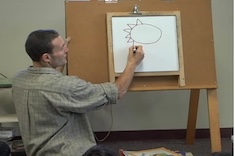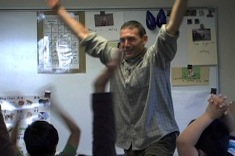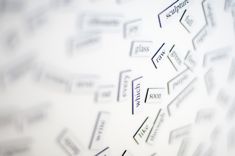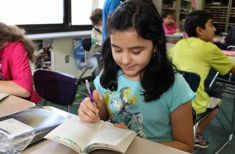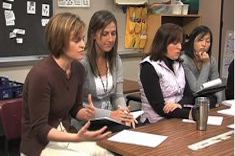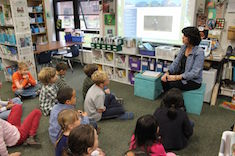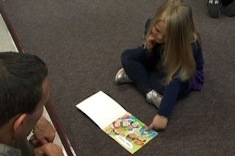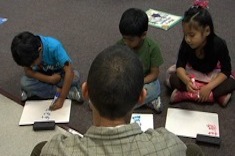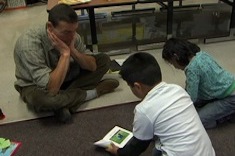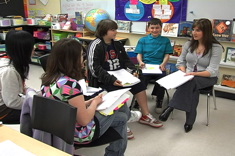Max Brand
Max’s teaching experience includes work in urban classrooms and the suburbs throughout central Ohio. He has worked at all grades at the elementary level (except 4th), and as Reading Recovery Teacher and Teacher Leader for the Ohio State Literacy Collaborative. Max is the author of two books, Word Savvy and Practical Fluency for Stenhouse Publishers.
All Content
Big Table Writing
Max Brand uses the “big table” in his kindergarten classroom as a communal spot for writing. You can see how he interrupts students naturally to make quick suggestions, and allows some interruptions of his own writing as he works with his students.
Drawing and Learning in Kindergarten
Max Brand demonstrates basic drawing strategies early in the year, and then has his kindergartners attempt similar pictures. He explains how the exercise builds basic skills both in literacy and hand/eye coordination.
Tutoring Carl: Sketching to Draft
Max Brand challenges himself to let a student take more of the lead during a writing tutoring session.
Making Memories Stick: Tutoring Kirk
Max Brand tutors a struggling fourth grader who produces very little writing.
The Power of Written Blind Word Sorts
Max Brand uses written blind word sorts to build student word learning skills.
Learning to Observe: Inviting a Parent to a Tutoring Session
Max Brand brings a mother into the assessment process and teaches her what to observe as her child reads.
Helping Parents Talk with Students
Helping parents learn to talk with their children about what’s going on in the classroom may be more valuable than any homework teachers assign. Max Brand shares some practical tips and prompts he gives to families to launch conversations at the dinner table or in the car.
Word Work Basics
Max Brand explains the basics of word work, including a list of reflective questions teachers can ask themselves and students.
Launching a Sort
Launching a sort with primary students early in the year begins not with words, but with leaves for Max Brand.
Tutoring Ruth: Designing an Assessment
Max Brand continues his new tutoring series. In this installment, he designs a creative intake assessment for Ruth, a first grader who struggles with following directions.
The Rapid Reader: Tutoring Esther
Max works with Esther, a third grader who takes pride in being a rapid reader and rarely pauses to make sense of the text.
Word Observations
Max Brand describes how word observations can work as powerful minilessons in elementary classrooms.
Simplifying Word Study
Max Brand has suggestions for simplifying word study.
Formative Spelling Assessment
Max Brand has developed templates for grades K-2 and 3-5 to use for formative spelling assessments.
Spelling Cycles: An Alternative to Weekly Spelling Lists
Max Brand developed Spelling Cycles as an alternative to weekly spelling tests. He explains how they work with an example from a third-grade class.
Creating Your Own Kindergarten Assessment
Max Brand finds standard assessments don’t always give him the information he needs when working with kindergarten English language learners, so he develops his own tool for analyzing book handling skills.
The Minimalist: Essential Texts for Kindergarten Teaching
Max Brand develops a "Swiss army knife" booklist of texts that he can't live without when teaching young learners.
Every Picture Tells a Story
Max Brand describes how he uses images to build reading and writing skills among his kindergartners.
Linking Movement, Minds, and Literacy in Kindergarten
Max Brand explains how movement activities in classrooms with young learners can be so much more than a brain break or “getting the wiggles out”: movement can forge potent connections between mind, body, and story. The essay includes two video examples.
Using Wipe-Off Boards with Young English Language Learners
Max Brand describes why wipe-off boards are such a valuable tool for work with young English language learners in small groups. The article includes a video demonstration.
Guided Reading with Kindergarten English Language Learners
Max Brand takes two kindergarten English language learners from reading a familiar book to exploring a new text, and explains in the debrief how he targets specific reading skills.
Flexible Grouping: When, How, and Why
Max Brand explains how daily student grouping can be both planned and spontaneous.
Digging Deep: The Power of Rereading
Max Brand considers how rereading helps students understand and enjoy texts.
Name Practice in Kindergarten
Max Brand uses a name chart with his kindergarten English language learners to teach letters and sounds, and build community.


